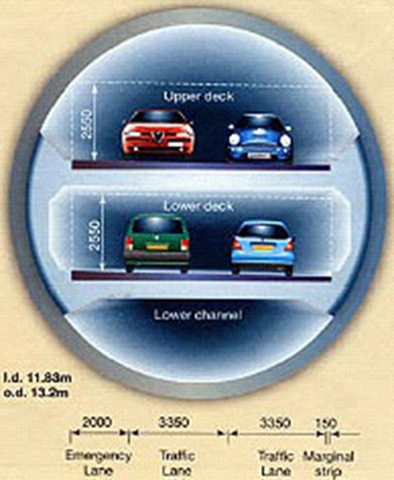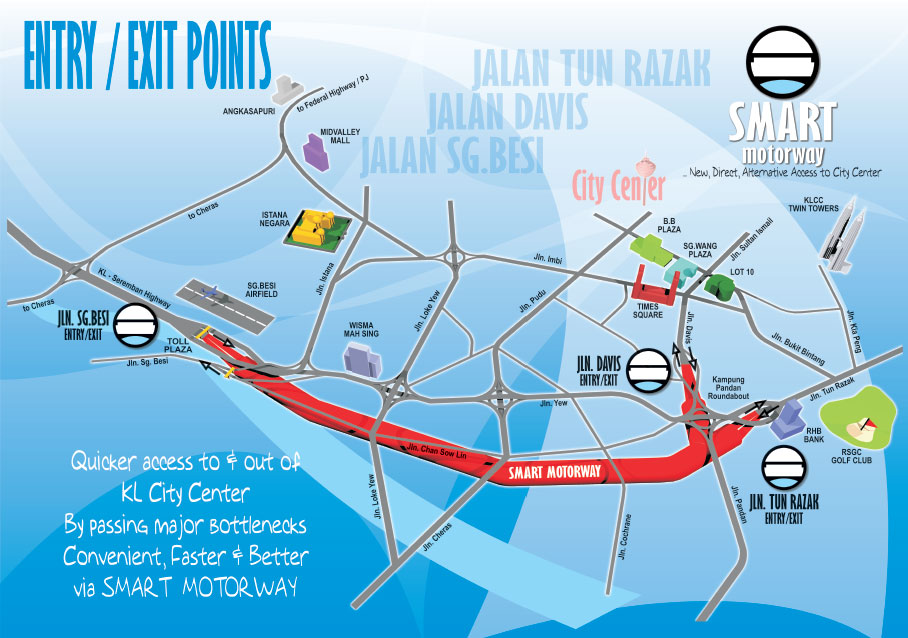What is SMART?
SMART is an acronym for Stormwater Management and Road Tunnel, a project under the Federal Government initiated to alleviate the flooding problem in the city centre of Kuala Lumpur. The project is implemented through a joint venture pact between MMC Corp Berhad and Gamuda Berhad with the Department of Irrigation And Drainage Malaysia and the Malaysian Highway Authority as the executing government agencies.
Studies had indicated that the critical stretch of Sungai Klang between Sg Klang /Sg Ampang confluence and Sg Gombak/ Sg Klang confluence to be flood prone areas and the fact that the river is further constrained by the Jalan Tun Perak Bridge (near Masjid Jamek) which is low, has resulted in the surrounding areas to experience flash floods.
The SMART system will be able to divert large volumes of flood water from entering this critical stretch via a holding pond, bypass tunnel and storage reservoir. This will reduce the flood water level at the Jalan Tun Perak Bridge, preventing spillover.
Other benefits of SMART
The Stormwater Management and Road Tunnel (SMART) project was incepted by the project proponent, namely MMC Corp Berhad-Gamuda Berhad Joint Venture, primarily to mitigate the recurring floods in the city of Kuala Lumpur, the financial, business and commercial hub of Malaysia. However, at the design stage of SMART, the dual purpose concept was born from the ingenuity of the project proponents and the motorway tunnel was integrated into the system to relieve traffic congestion at the main Southern Gateway to the city centre.
The Motorway to Ease Congestion
The motorway tunnel will provide an alternative route for motorists from the Southern Gateway, i.e. KL-Seremban Highway, Federal Highway, Besraya and East-West Link entering and exiting the city centre. This will reduce traffic congestion at the Southern Gateway leading to the city centre. The travel time will be reduced significantly. For example from the Jalan Istana Interchange-Kampung Pandan the expected travel time is a mere four minutes compared to ten to fifteen minutes using the existing roads.
Unique Features
Since safety of vehicles in the motorway will be of paramount importance, SMART Tunnel has additional features that are unique over and above the features seen in a normal motorway tunnel. The main features are:
1. Automated Flood Control Gates
2. Cross Passage
3. Ventilation/Escape Shafts
4. Radio Re-Broadcasting Services
5. Air Quality Monitoring Equipment (AQME)
6. SCADA Monitoring & Surveillance
7. Other Emergency Equipments
1. Automated Flood Control Gates
The water tight gates are installed on either ends of the motorway tunnel (within the stormwater section). In addition similar single flood control steel gates are installed at both entrances and exits of the motorway tunnel. These gates are operated using a hydraulic system.
• 3 automated flood gates at both end of motorway
• 2 automated road gates at both end junction boxes
2. Cross Passage
Cross Passage between decks at 250m intervals: the passage acts as emergency exits during an emergency.
3. Ventilation/Escape Shafts
Ventilation/ escape shafts at 1km intervals. These powerful air ventilators will constantly renew the air and maintain the air quality within the motorway. To protect the ventilation system during the flooding, the system consists of a series of shafts each containing an exhaust and fresh air injector. This design enables the fans to be installed outside the SMART tunnel to create a longitudinal flow in the tunnel between the shafts that permits the air in the tunnel to be continuously renewed and the extraction of the exhaust fumes. The feature also allows for smoke control in the event of a fire.
4. Radio Re-Broadcasting Services
Radio re-broadcasting is an audio (sound) broadcasting service, traditionally broadcast through the air as radio waves (a form of electromagnetic radiation) from a transmitter to an antenna and finally to a receiving device. Stations can link in radio networks to broadcast common programming, either in syndication or simulcast or both. Audio broadcasting also can be done via cable FM, local wire networks, satellite and the Internet. With the radio re-broadcasting services available in Smart Tunnel, user should be able to receive the radio channel, hand phone and other maintenance communication reception without any interference.
5. Air Quality Monitoring Equipment (AQME)
There are 38 sets of AQME monitoring carbon monoxide (CO), nitrogen monoxide (NO) and particulate. They are cited in the upper and lower decks. The ventilation system will be operated automatically based on the air quality monitoring system outputs. The ventilation will provide for the supply and extract of air for both the upper and lower road decks and consists of 4 nos. of ventilation shafts each containing 8 set of fans.
6. SCADA Monitoring & Surveillance
State-of-the-art SCADA monitoring and surveillance of SMART at its 24-hour SMART Highway. Smart Tunnel is equipped with more than 212 units of Closed Circuit Television and BARCO Wall is able to show 70 CCTVs screen at one time. Automatic detection systems use video images and laser beams processing to detect unusual events.
7. Other Emergency Equipments
Equipped with firefighting equipment, telephone and surveillance at 1 km interval. Hydrant & Fire Extinguishers located every 90m along slow lane of both tunnel road decks. Hose Reel, Fire Extinguishers, Break glass and Emergency Telephone located within each cross passages, ventilation shafts and escape shafts.
Source from http://www.smarttunnel.com.my/













2 comments:
To me automatic flood control gates are counter productive. I think they are the main reason why frequent shutdown of the road tunnel.
Flood water detention capacity for this tunnel is 2,750,000 cubic meter minus the road tunnel. The road tunnel is made up another 250,000 cubic meter. Why on earth the road tunnel was closed in many occasion even though the biggest flood to date is well below 1,400,000 cubic meter?
it is because mode 1 of the tunnel does not function as mode 1.during mode 1 of the tunnel,the bottom level of the tunnel is not supposed to have water even there is no rain.but,currently,even there is no rain, the bottom level of the tunnel is filled with water.therefore there are only 2 choices left which is mode 2 (to fill up the lower deck with rainwater) and 3 (to fill up the upper deck with water).mode 2 is for normal rain and mode 3 is for heavy rain
Post a Comment
Thank you for your comment....Admin GMK Web Blog